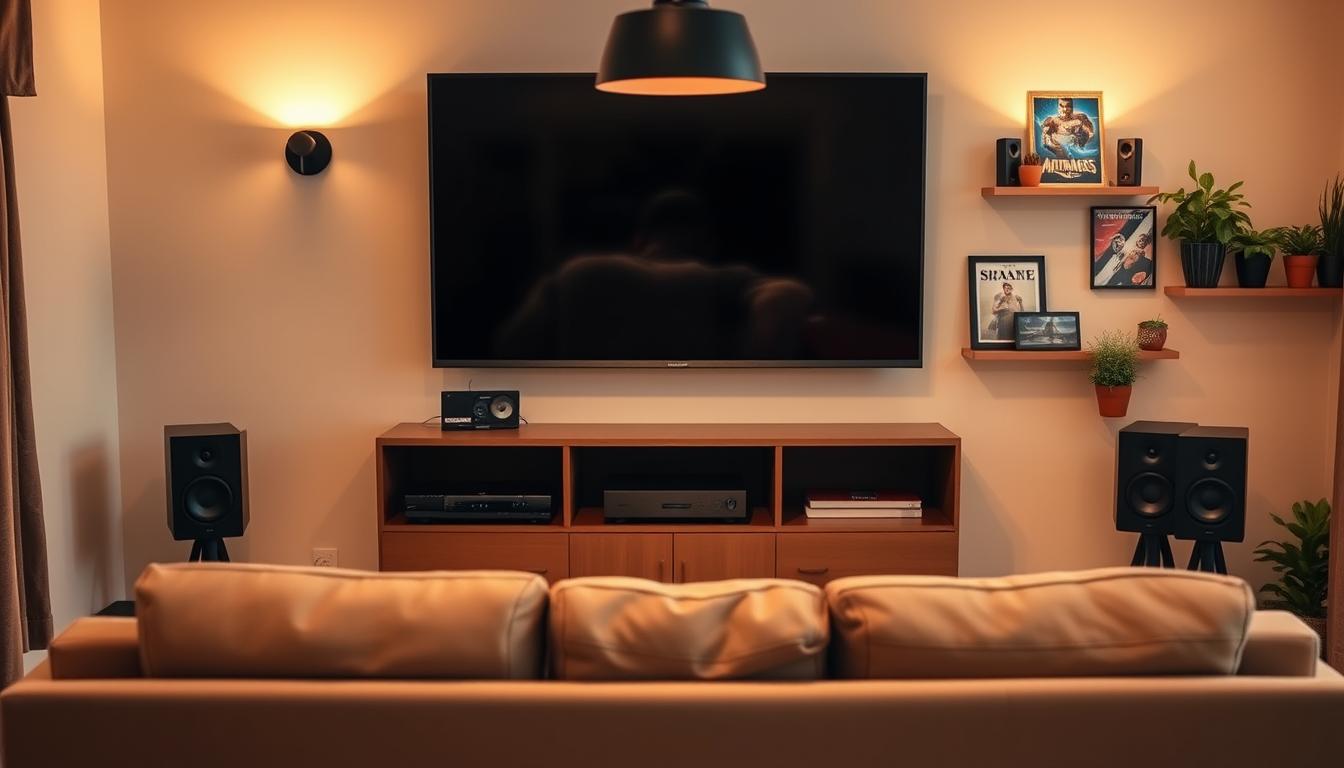Did you know modern budget TVs now outperform projectors costing three times as much? Brands like TCL, Vizio, and Samsung offer models under $500 with 4K resolution and HDR that rival premium setups. This revelation shatters the myth that cinematic experiences require lavish spending.
Creating an immersive entertainment space isn’t about emptying your wallet. It’s about strategic upgrades to your existing setup. For example, optimizing speaker placement or adjusting room lighting can dramatically enhance audio and visual quality—no renovation required.
Industry experts emphasize prioritizing components that deliver the most impact. A crisp display paired with properly positioned speakers often matters more than chasing high-end specs. Even simple tweaks, like blackout curtains or acoustic panels, elevate your viewing experience without draining savings.
Explore budget-friendly upgrades that balance performance and cost. You’ll learn how to avoid overspending on unnecessary features while maximizing what you already own. Let’s transform your living space into a theater that feels premium—not penny-pinched.
Key Takeaways
- Modern budget TVs often outperform pricier projectors in picture quality
- Strategic upgrades beat full-system replacements for cost efficiency
- Room optimization techniques multiply your setup’s potential
- Mid-range audio gear delivers premium sound when positioned correctly
- Focus spending on components offering the biggest quality leap
Introduction to Budget Home Theater Setups
Cinematic-quality entertainment now fits everyday budgets thanks to affordable home theater tech. While premium systems once dominated living rooms, today’s $500–$2,000 setups rival commercial theaters. Brands like Vizio and TCL deliver crisp visuals, while Roku and Fire TV streamline streaming—all without luxury price tags.
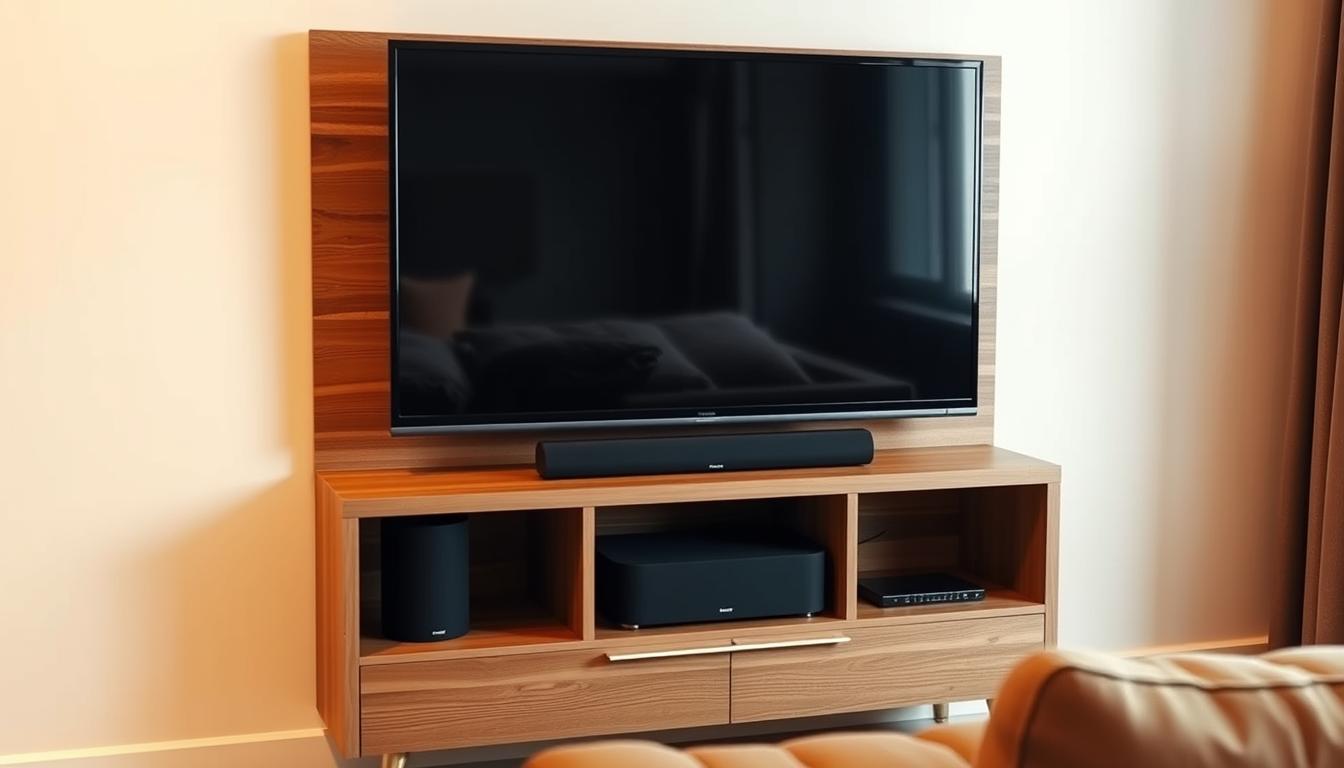
The secret? Focus on core gear first. A mid-range 4K TV paired with a Dolby Atmos soundbar creates immediate impact. “You don’t need seven speakers to feel immersed,” notes AV expert Mark Harris. “Strategic placement of 3-5 channels often outperforms poorly arranged premium systems.”
Smart timing matters too. Black Friday deals and post-holiday sales slash prices on last year’s models. Many 2022 TVs now cost 40% less while offering near-identical features to 2024 releases. This approach lets you allocate savings toward acoustic treatments or seating upgrades.
Modern budget components surprise with their longevity. Today’s $300 soundbars outperform $1,500 receivers from 2018 in wireless connectivity and voice control. By prioritizing versatile home theater gear, you build a system that evolves with tech trends instead of requiring full replacements.
Defining Your Home Theater Goals and Space Requirements
Mismatched equipment ranks among the top reasons for buyer’s remorse in home entertainment projects. Start by sketching your room’s layout with exact dimensions—width, length, and ceiling height. These numbers dictate whether a 5.1 surround system will enhance your experience or become an echoing nightmare.
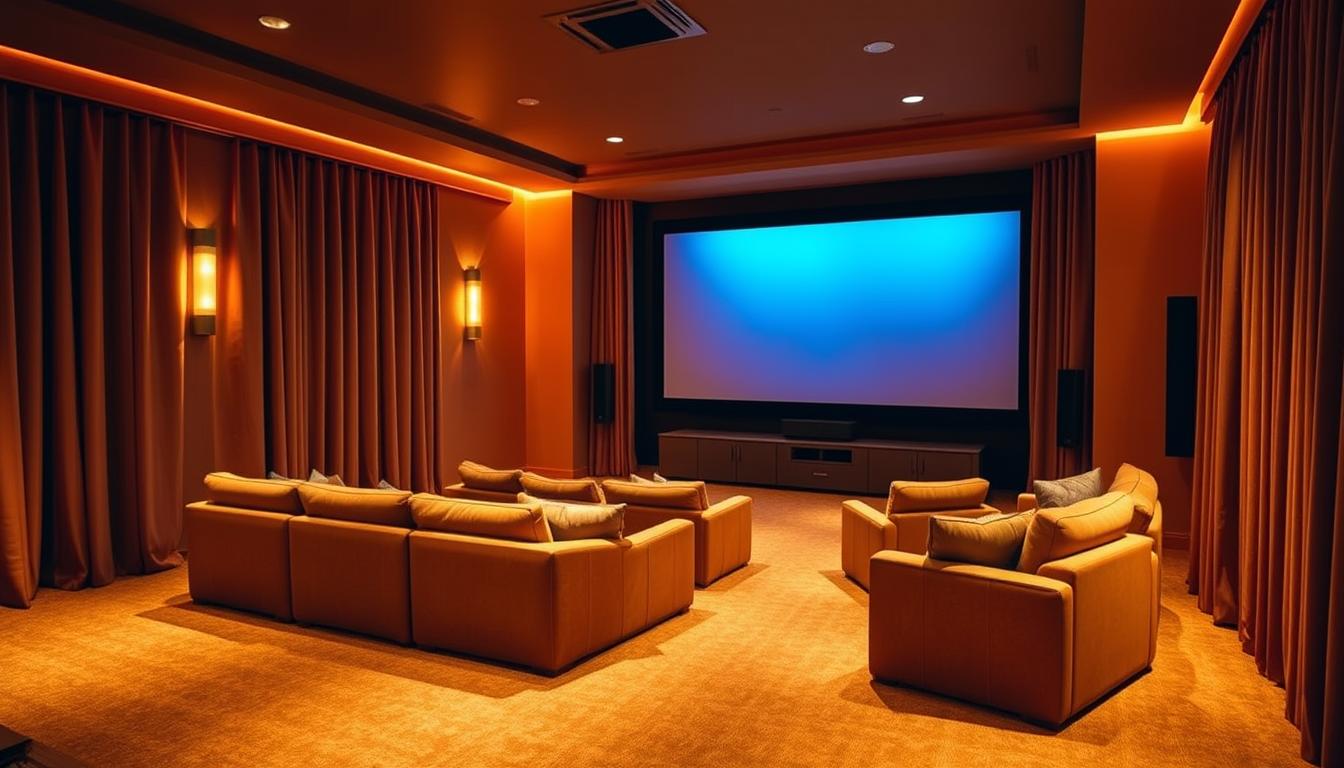
Smaller spaces under 200 square feet thrive with compact soundbars and 55-inch screens. Larger areas exceeding 400 square feet demand more robust audio solutions. Room acoustics matter just as much as speaker quality—hardwood floors and bare walls amplify treble harshness, while carpets and drapes absorb excess noise.
Your viewing habits shape equipment choices. Sports enthusiasts benefit from brighter displays with faster refresh rates, while movie buffs need deeper blacks and wider color ranges. Gaming setups demand low-latency connections that standard streaming devices might lack.
Measure seating distances carefully. The ideal screen size correlates with how far you sit—multiply your viewing distance (in feet) by 0.84 to calculate maximum recommended screen inches. This prevents eye strain and ensures immersive visuals without overwhelming your space.
Balance ambitions with reality. Apartment dwellers might skip subwoofers to respect neighbors, while families prioritize durable, kid-friendly furniture. “Your theater should adapt to your life,” advises AV designer Lisa Tanaka. “Future-proof with modular components that grow with your needs.”
How to Set Up a Home Theater on a Budget
Transform your living area into a cinematic escape using cost-effective upgrades. Start with a quality display and entry-level sound system—these form the foundation of your budget-friendly experience. Mid-range TVs under $600 now support Dolby Vision, while compact soundbars deliver virtual surround sound.
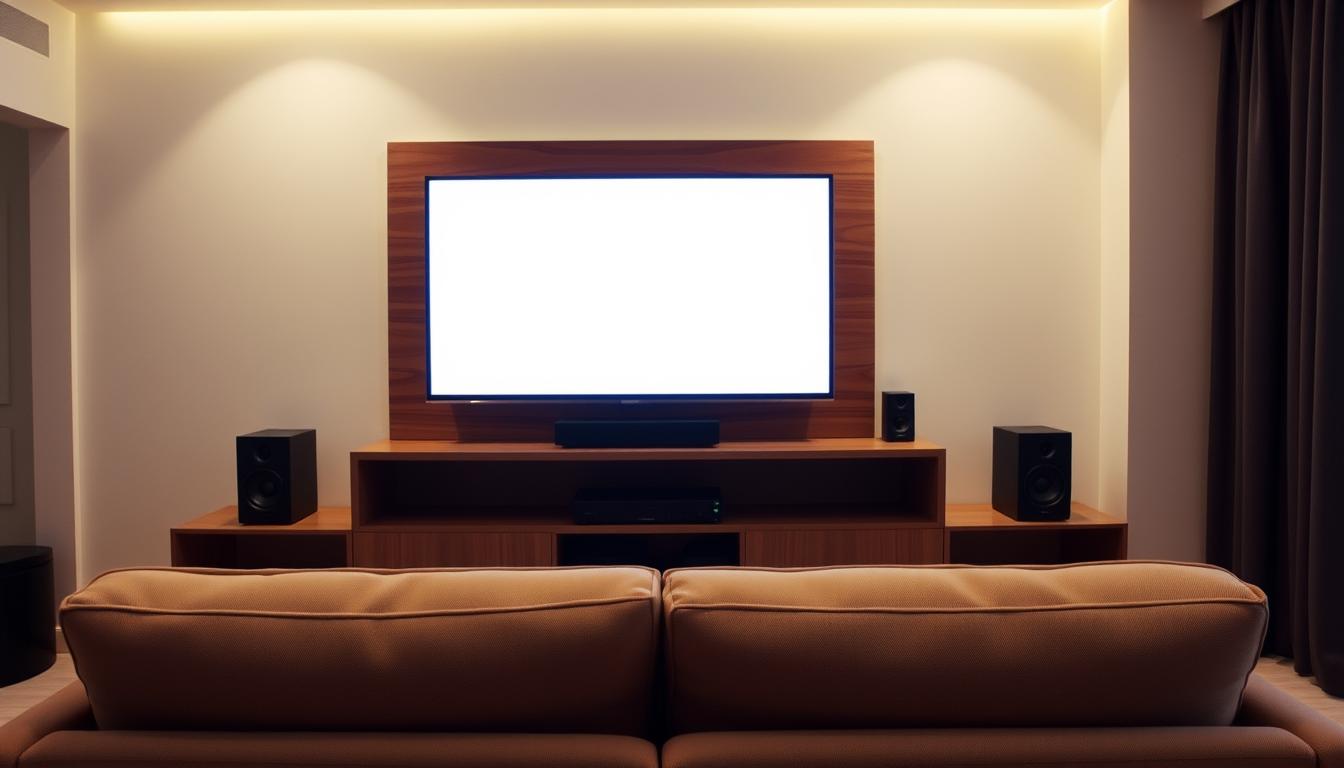
Prioritize components offering the biggest quality leap. A 65-inch 4K TV paired with dual rear speakers often outperforms premium 55-inch models with basic audio. AV specialist Rachel Nguyen confirms: “80% of immersion comes from screen size and speaker placement—not price tags.”
| Strategy | Budget Impact | Result |
|---|---|---|
| Focused Upgrades | 35% Savings | Enhanced Clarity |
| Separate Purchases | Better Compatibility | Future Expansion |
| Seasonal Deals | 50% Off MSRP | Premium Gear Access |
Time purchases with market cycles. Last year’s receiver models drop 40% when new versions launch. Open-box items at Best Buy or Amazon Warehouse offer full warranties at 20-30% discounts. This approach lets you stretch funds further without sacrificing reliability.
Build your system incrementally. Start with 3.1 channel audio, then add rear speakers later. Choose HDMI 2.1-compatible devices to support gaming consoles and 8K content. These decisions create room for growth while maintaining immediate enjoyment.
Planning Your Audio Experience
Great audio transforms movies from background noise to emotional journeys. Start with two floorstanding speakers instead of chasing complex systems. These deliver rich bass and crisp dialogue without needing extra components.
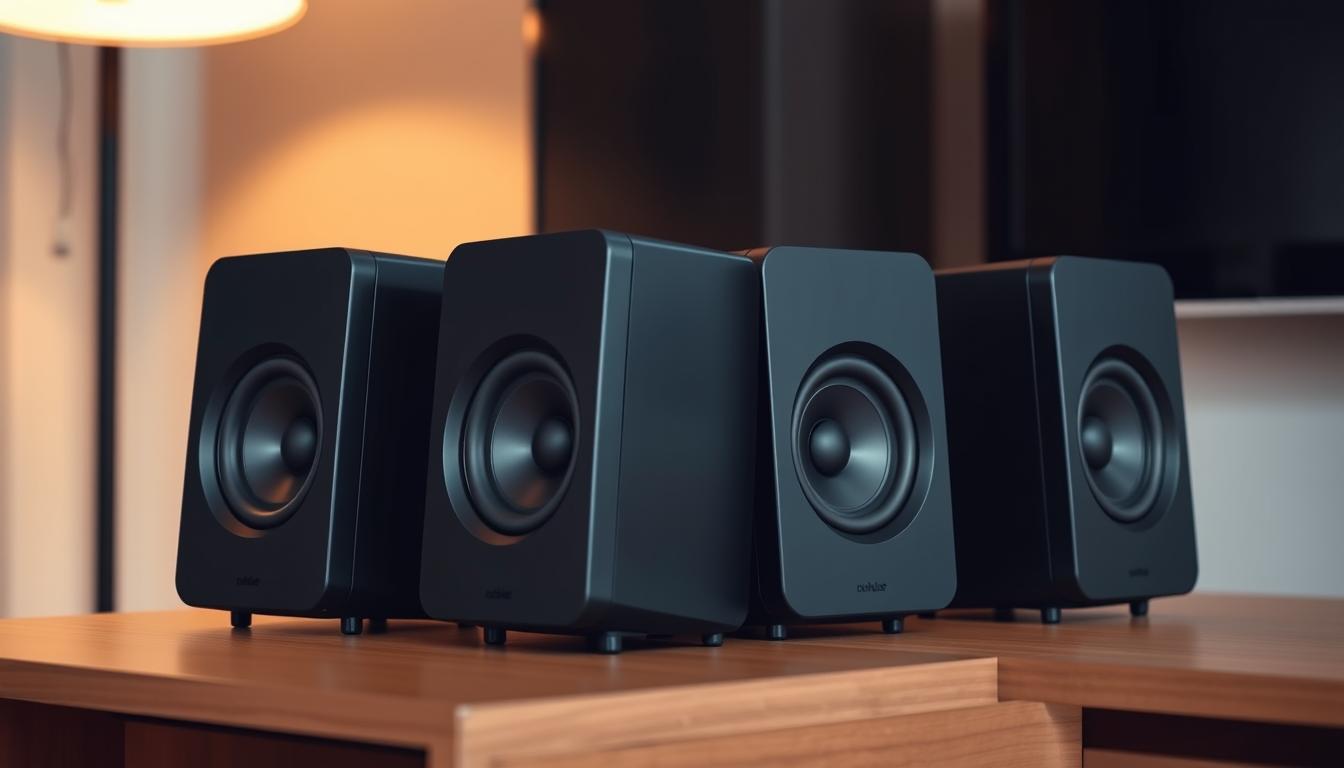
Speaker Selection and Options
A 2.0 setup outperforms cheap surround systems when space or funds are limited. “Two great speakers beat six mediocre ones every time,” says audio engineer Carla Simmons. Focus on models with 88dB+ sensitivity ratings—they pair better with budget receivers.
| Setup | Components | Best For |
|---|---|---|
| 2.0 Stereo | 2 Floorstanding | Small Rooms |
| 3.1 System | 3 Speakers + Sub | Movie Nights |
| 5.1 Surround | 5 Speakers + Sub | Large Spaces |
Optimizing Sound Quality on a Budget
Position speakers at ear level when seated. Angle them toward your main viewing area using the equilateral triangle method. This simple tweak improves stereo imaging more than expensive cables.
Match speakers with receivers rated for 20% more power than their RMS needs. Entry-level Denon or Yamaha models often handle 6-8 ohm loads effectively. Avoid clipping issues by keeping volume below 75% during action scenes.
Choosing the Right Video Display
Your viewing experience hinges on one critical decision—selecting the optimal balance between screen size and visual clarity. Modern displays split into two camps: self-contained TVs and expansive projector setups. Each option carries distinct advantages shaped by your room’s conditions and viewing priorities.
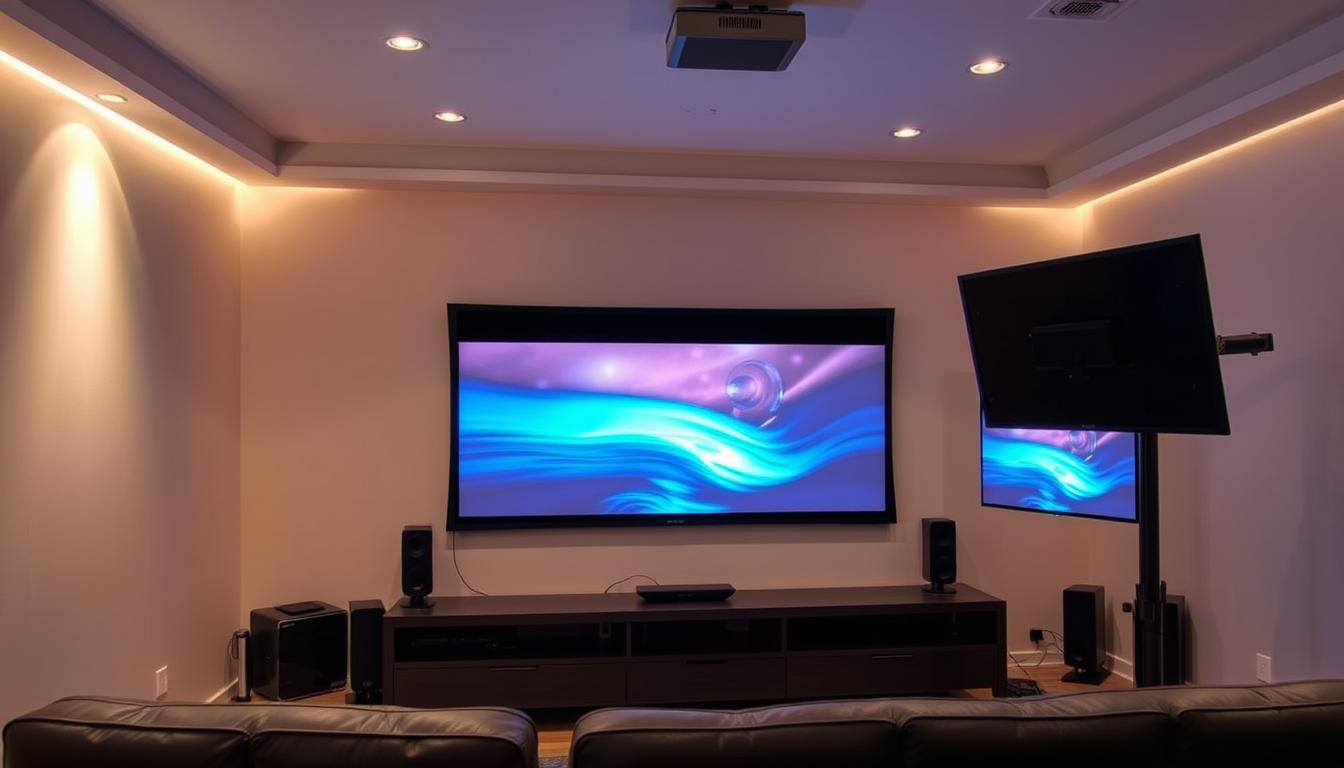
TV vs. Projector: Benefits and Drawbacks
Televisions dominate in bright rooms with their superior color accuracy. Brands like TCL and Vizio deliver 4K HDR visuals under $500 that outshine many projectors. “A quality 65-inch TV often provides sharper images than a $1,500 projector setup,” notes tech reviewer Emily Carter.
Projectors unlock cinematic scale, transforming walls into 120-inch canvases. Models like the BenQ HT2050A offer 1080p clarity under $1,000. But they demand light-controlled spaces and proper mounting—factors adding 30-40% to total costs.
Selecting the Best Screen for Your Room
Measure your viewing distance first. Sit 8 feet away? A 65-75″ TV suffices. Want theater-scale immersion? Projectors require 12+ feet for 100″ screens. Dark-painted walls or blackout curtains become essential for projector setups.
Consider hidden expenses. Projector screens cost $150-$500, while TV mounts run $20-$200. For multi-use spaces, TVs maintain performance during daytime viewing—crucial for building a dedicated home theater room later.
| Factor | TV Advantage | Projector Edge |
|---|---|---|
| Bright Rooms | Superior Visibility | Requires Darkness |
| Installation | Plug-and-Play | Professional Setup |
| Total Cost | $300-$1,500 | $800-$3,000+ |
Budgeting for Quality Equipment
Smart spending separates impressive systems from money pits. Focus on core components that deliver daily value—audio clarity and visual fidelity—before considering luxury add-ons. Entry-level 5.1 surround systems under $500 now rival premium brands in mid-sized rooms when paired with proper placement.
Allocate 60% of your funds to display and sound. Mid-range TVs ($400-$800) with QLED panels and Dolby Vision outperform basic 4K models in color accuracy. “Invest in components you interact with most,” advises tech analyst Jason Miller. “A $200 center channel speaker improves dialogue more than $1,000 seating.”
| Component | Budget Range | Premium Range | Value Gain |
|---|---|---|---|
| Audio System | $300-$700 | $1,500+ | 35% Better Imaging |
| Display | $500-$1,000 | $2,500+ | 20% Color Accuracy |
| Seating | $150/seat | $600/seat | Comfort vs. Cost |
Research warranties and repair costs. Many $800 receivers last 7+ years, while $300 models often need replacement in 3-4 years. Factor in $100-$300 for acoustic panels or blackout curtains—these enhancements multiply your equipment’s performance.
Set aside 15% of your total budget for unexpected needs. HDMI 2.1 cables, mounting brackets, and surge protectors frequently add $80-$150 to projects. This cushion prevents compromises when finalizing your setup.
Maximizing Surround Sound Without Breaking the Bank
Exceptional audio transforms movie nights from casual viewing to theater-grade immersion. Modern solutions let you achieve cinematic depth without premium pricing. Your choice between streamlined soundbars and traditional speaker systems depends on space constraints and listening priorities.
Compact Convenience vs. Full Immersion
Soundbars deliver instant upgrades over TV speakers. The Sonos Beam exemplifies this approach—its crisp dialogue and balanced bass outperform most built-in audio systems. Wireless subwoofers can later enhance low-frequency effects for action fans.
Dedicated speaker setups require more planning but offer superior directional effects. Five discrete channels create precise overhead and rear effects that even high-end soundbars struggle to replicate. This audio separation proves crucial in larger rooms where sound needs to travel further.
Consider your room’s limitations first. Apartments benefit from soundbars’ space-saving designs and minimal wiring. Homes with dedicated media rooms justify the investment in separate speakers and subwoofers. Both approaches allow gradual expansion, letting you prioritize immediate needs while planning future enhancements.
FAQ
Can I get quality surround sound without buying expensive speakers?
Yes. Brands like Polk Audio and Micca offer affordable bookshelf speakers or satellite systems. Pair them with a budget-friendly subwoofer, like the Monoprice 9723, for deeper bass. Focus on proper placement—position speakers at ear level and use a receiver with room calibration to optimize performance.
Is a projector better than a TV for a budget home theater?
Projectors, such as the Epson Home Cinema 880, provide larger screens but require controlled lighting. TVs like the TCL 6-Series offer brighter images in well-lit rooms. Choose based on your space: projectors excel in dark environments, while TVs deliver sharper details without extra setup.
How do I improve audio quality without upgrading equipment?
Use acoustic panels to reduce echoes or reposition speakers for better imaging. Calibrate your system using free tools like Audyssey MultEQ. Even adding thick curtains or rugs can minimize sound reflections, enhancing clarity without spending money.
What’s the minimum room size needed for a surround setup?
A 10×12-foot room works for a 5.1 system. Ensure seats are 8–12 feet from the screen. Smaller spaces can use compact speakers like the Bose Acoustimass series, while larger rooms may need higher-wattage receivers, such as the Yamaha RX-V385, to fill the area.
Are soundbars a good alternative to full surround systems?
Soundbars like the Vizio V-Series save space and cost but lack the immersive rear-channel effects of systems like the Logitech Z906. For tighter budgets, they’re a solid start—look for models with wireless subwoofers and Dolby Atmos support.
Can I use a painted wall as a projector screen?
Yes. Matte white or gray paint (e.g., Sherwin-Williams ProClassic) reduces glare and improves contrast. Ensure the surface is smooth. For a DIY screen, use blackout cloth stretched over a frame—it’s cheaper than commercial screens and still delivers sharp images.
What features matter most in a budget AV receiver?
Prioritize 4K/HDR passthrough, HDMI 2.1 ports, and Dolby Atmos compatibility. Models like the Denon AVR-S660H offer these at mid-range prices. Avoid extras like Wi-Fi if you’re streaming via a separate device to keep costs low.
How do I reduce ambient light for a projector setup?
Install blackout curtains or apply window tint film. Use dark, non-reflective paint on walls and ceilings. Position the projector away from light sources, and consider bias lighting behind the screen to improve perceived contrast without raising room brightness.
